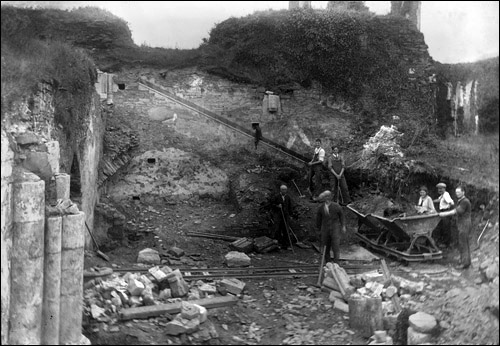Neath Abbey ruins, Neath
Neath Abbey ruins, Neath

Excavation of Neath Abbey c.1926 © Neath Antiquarian Society
The remains of this abbey are remarkably well preserved, considering the site became a copper works during the Industrial Revolution!
By Charter of 1129, Richard de Granville – a Norman knight who participated in the conquest of Glamorgan – granted a large tract of land to the Savigniac monastic order for the building of a new monastery on land west of the river Neath. In October 1130, an Abbott and 12 monks arrived, initiating over 400 years of monastic occupation, by Savigniacs and later by Cistercians.
The oldest surviving buildings, dating from 1170 to 1220, are those on the western range, originally occupied by the lay brothers and facing onto the cloister. The great Abbey Church was built c.1280-1330 by the energetic Abbot Adam of Carmarthen to replace an earlier, smaller church. The building, now a ruin, was 203ft (61.9m) in length and 150ft (45.7m) in width. The buttresses at the western end give visitors an idea of the structure’s height.
King John visited in 1210. He had granted charters of confirmation to the abbey. The abbey was enlarged from c.1280 onwards, when it was one of Wales’ wealthiest monastic institutions. It was home to c.50 monks. Lay brothers also helped to run the institution, working on the abbey estates. Their tasks probably included mining coal for heating.
King Edward II took refuge here in 1326. He had been deposed and travelled in disguise around Wales.
The abbey was repeatedly attacked by Welsh rebels, including supporters of Owain Glyndŵr c.1405, and was closed by the government in 1539. A mansion was subsequently built in one corner of the cloisters but fell out of use after c.100 years.
The Industrial Revolution transformed the area. In the late 18th century, a copper-smelting works occupied the abbey site, with abbey buildings accommodating workers. The spectacular remains of Neath Abbey ironworks are just a short walk from the Abbey site (see map below).
The abbey was excavated in the 1920s and 1930s by Glen Taylor of Neath Antiquarian Society with 40 volunteers. They removed thousands of tons of debris including copper slag which, in the Abbey Church, lay some 5.2m (17ft) deep above the original floor surface! The upper photo, courtesy of Neath Antiquarian Society, shows the excavations c.1926 – the diagonal line on the wall is the handrail of the stairs which the monks used to reach the church during darkness. Today a plaque at this location shows the depth of material removed.
The aerial photo, courtesy of the Royal Commission on the Ancient & Historical Monuments of Wales, shows the ivy-covered abbey walls in 1933. It is from the Aerofilms Collection of the National Monuments Record of Wales.
The site passed into the government’s ownership in 1944. The ruins are now owned by Cadw. Follow the link below for information on visiting.
With thanks to Neath Antiquarian Society
Postcode: SA10 7DW View Location Map
Neath Abbey visitor information – Cadw website
More on the abbey’s history – Monastic Wales website
Copies of the aerial photo and other images are available from the RCAHMW. Contact: nmr.wales@rcahmw.gov.uk


